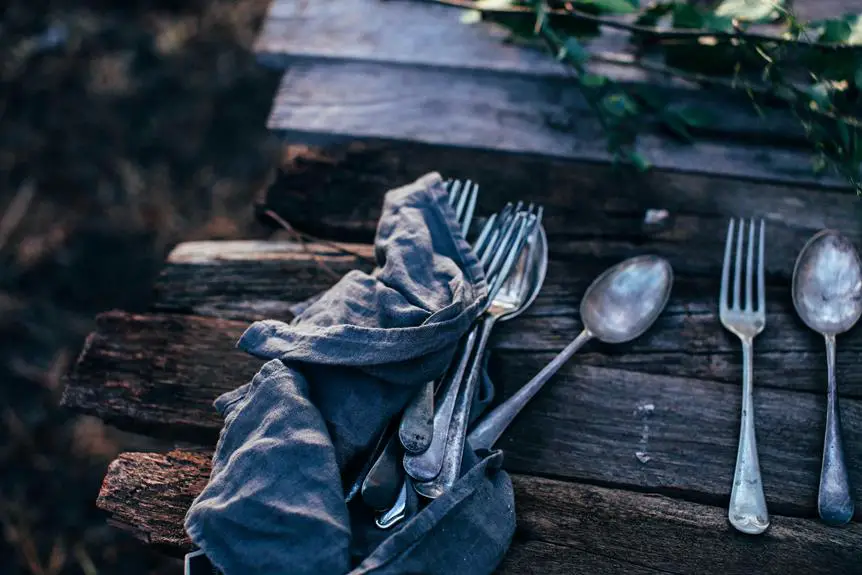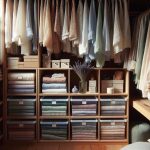You might not realize it, but the way you handle your fabrics can make a significant difference in their appearance. By using proper folding techniques and effective storage solutions, you can prevent those annoying creases that detract from your garments. It's not just about aesthetics; it's also about extending the lifespan of your clothes. If you think managing fabric is straightforward, you may be overlooking some critical factors that could transform your approach. Let's explore how a few simple adjustments can lead to noticeable improvements in your wardrobe.
Table of Contents
Key Takeaways
- Proper handling techniques, such as gentle folding and rolling, minimize sharp creases and maintain fabric integrity.
- Using appropriate hangers for different fabric types supports garment shape and reduces stress on seams.
- Storing fabrics in breathable bags prevents moisture buildup, which can lead to swelling and creasing.
- Regularly monitoring humidity levels helps maintain optimal fabric conditions and reduces wrinkle formation.
Understanding Fabric Types
Knowing the different fabric types can help you choose the best handling methods to prevent unwanted creases.
Fabrics like cotton and linen are natural fibers that tend to wrinkle more easily. You'll want to handle these with care, as rough treatment can set creases that are tough to remove.
Polyester, on the other hand, is a synthetic fiber that resists wrinkling, allowing you to be less cautious during handling.
Silk is another delicate fabric that requires special attention. Its smooth surface can show creases readily, so you should avoid folding it when possible. Instead, consider hanging silk garments to maintain their elegance.
Wool, while more resilient, can still wrinkle if improperly stored or packed. It's best to roll wool clothing instead of folding to minimize creasing.
Additionally, blends of fabrics can behave differently than their individual components. For example, a cotton-polyester blend may wrinkle less than pure cotton but still requires careful handling.
By understanding these distinctions, you can tailor your approach to each fabric type, ensuring your garments stay crisp and looking their best.
Proper Folding Techniques
When it comes to folding fabric, using the right techniques can make all the difference.
You can choose between the flat folding method for neatness or the rolling technique for space-saving benefits.
Let's explore how each method can help you keep your fabrics crease-free.
Flat Folding Method
Mastering the flat folding method can significantly reduce creases in your fabrics. This technique allows your items to lay flat, minimizing pressure on the fabric and preventing unsightly wrinkles. Here's how you can do it effectively:
- Start by laying the fabric on a clean, flat surface.
- Smooth out any wrinkles with your hands.
- Fold one side towards the center, then repeat with the other side, ensuring the edges align.
- Finally, fold the item in half or thirds, depending on its size.
Using the flat folding method not only keeps your fabrics looking pristine, but it also maximizes storage space. It's particularly useful for delicates and formal wear.
| Step Number | Action | Emotion Evoked |
|---|---|---|
| 1 | Lay flat | Calmness |
| 2 | Smooth wrinkles | Satisfaction |
| 3 | Fold neatly | Pride |
Rolling Technique Benefits
While the flat folding method is effective, the rolling technique offers unique benefits that can further help prevent creases and maximize space in your storage.
When you roll your fabrics, you reduce the likelihood of sharp folds that often lead to unwanted creases. This method encourages a more gentle handling of fabric, which is especially important for delicate materials.
Rolling also allows you to see everything at a glance. You can easily identify what you have without rummaging through piles, saving you time and effort. This visual organization can help you decide which fabric to use for your next project without the hassle of unfolding and refolding.
Additionally, rolling your fabric is space-efficient. It can fit into tight spaces, such as drawers or bins, more effectively than flat folding. This means you can store more items without overcrowding your storage area.
Lastly, rolling is a great way to transport fabric. Whether you're heading to a crafting session or a sewing class, rolled fabrics are easier to carry and less likely to become wrinkled during transit.
Effective Storage Solutions
Effective storage solutions can significantly reduce creases by ensuring fabrics are kept in the right conditions. When you store your fabrics properly, you're not just preventing wrinkles; you're also prolonging their lifespan. Here are some effective strategies you can use:
- Use breathable storage bags: Opt for cotton or linen bags instead of plastic. These materials allow air circulation, preventing moisture buildup that can cause creases and mildew.
- Avoid overcrowding: Keep your fabrics spaced out. Overstuffing shelves or drawers creates pressure points, leading to unwanted creases.
- Store fabrics flat: If possible, lay heavier fabrics flat. For lighter materials, consider rolling them to minimize creasing while saving space.
- Regularly check conditions: Periodically evaluate your storage area for humidity and temperature. Keeping fabrics in a cool, dry environment helps maintain their integrity.
Handling Garments With Care
When you handle garments with care, you can prevent unnecessary creases and maintain their appearance. Start by ensuring your hands are clean and dry to avoid transferring dirt or moisture onto the fabric. When picking up a garment, support its weight evenly. This reduces stress on seams and prevents distortion.
As you fold or hang clothes, keep in mind the right techniques. For hanging, use appropriate hangers that match the garment type—padded hangers for delicate fabrics and sturdy ones for heavier items. When folding, avoid sharp creases by using a gentle approach and smooth out any wrinkles as you go.
Be mindful of how you transport garments, too. If you're packing them for a trip, roll them instead of folding, or use garment bags. This minimizes pressure points that lead to creases. Always store clothes in a way that allows them to breathe, avoiding overcrowding in closets or drawers.
The Role of Humidity
Humidity plays a crucial role in how fabrics behave, as it can either relax or tighten the fibers, leading to potential creases. When the humidity level is too high, fabrics can absorb moisture, causing them to swell and become more prone to wrinkling. Conversely, low humidity can dry out fibers, making them stiff and less flexible.
To manage fabric handling effectively, consider the following:
- Monitor Humidity Levels: Keep an eye on the humidity in your storage area. Ideally, it should be between 40-60% for optimal fabric care.
- Use Moisture-Wicking Storage Solutions: Invest in breathable garment bags or storage bins to help control moisture absorption.
- Avoid Direct Heat Sources: Keep fabrics away from heaters or radiators, which can dry them out and create creases.
- Pre-Treat Fabrics: Before storing or using, consider lightly misting fabrics with water to maintain flexibility without over-saturating them.
Ironing and Steaming Tips
When it comes to ironing and steaming, choosing the right tool can make all the difference.
You'll want to master effective techniques to ensure your fabrics look their best without any unwanted creases.
Let's explore how to achieve smooth results with ease.
Choosing the Right Tool
Selecting the right tool for ironing or steaming can make a significant difference in keeping your fabrics smooth and crease-free. With so many options available, you need to consider what works best for your specific needs. Here are some tips to help you choose:
- Iron Type: Decide between a traditional steam iron or a garment steamer. Steam irons are great for heavy fabrics, while steamers are ideal for delicate materials and quick touch-ups.
- Heat Settings: Look for an iron or steamer with adjustable heat settings. Different fabrics require different temperatures, so having this feature is essential to avoid damage.
- Water Reservoir: If you opt for a steam iron or steamer, check the water reservoir size. A larger tank means less frequent refilling, allowing for uninterrupted steaming or ironing sessions.
- Corded vs. Cordless: Consider whether you prefer a corded model for constant power or a cordless one for freedom of movement. Each has its advantages depending on your workspace.
Techniques for Effective Ironing
Mastering effective ironing techniques can transform your fabric care routine, ensuring smooth, crease-free results every time.
Start by sorting your clothes based on fabric types, as different materials require different heat settings. Always check the care label for guidance.
When you're ready to iron, ensure your iron's plate is clean to avoid transferring dirt to your fabrics. Fill the iron with water if you're using the steam function, and adjust the temperature accordingly. For delicate fabrics, use a pressing cloth to prevent shine and damage.
Begin with larger items like shirts and trousers, moving to smaller pieces last. Iron inside out when possible, especially for dark colors, to protect the surface. Use slow, steady strokes, and avoid going over the same area repeatedly, which can cause shine or scorch marks.
For stubborn creases, mist the fabric lightly with water before ironing, or use vertical steaming for hanging garments. Lastly, hang or fold your freshly ironed clothes promptly to maintain their crisp appearance.
With these techniques, you'll achieve professional-looking results right at home!
Frequently Asked Questions
How Do Different Fabrics React to Temperature Changes?
Different fabrics react uniquely to temperature changes. For instance, cotton shrinks in heat, while polyester resists it. You'll notice silk may become more delicate, so understanding these reactions helps you choose appropriate care methods for your garments.
What Tools Can Help in Identifying Fabric Types?
You can use fabric swatch books, burn tests, and magnifying glasses to identify fabric types. Each tool helps you analyze texture, fiber content, and characteristics, ensuring you know exactly what you're working with for your projects.
Can Fabric Blend Types Affect Crease Formation?
Yes, fabric blend types can affect crease formation. Fabrics with higher synthetic blends tend to resist creasing better than natural fibers. Understanding your fabric's composition helps you choose the right care methods to minimize creases effectively.
How Often Should I Inspect Stored Fabrics?
You should inspect stored fabrics at least every few months. Regular checks help you catch any issues early, ensuring your fabrics remain in good condition and ready for use whenever you need them.
Are There Specific Storage Solutions for Delicate Fabrics?
You should use acid-free tissue paper and breathable garment bags for delicate fabrics. Avoid plastic containers that trap moisture. Store items flat or hanging, ensuring they're not compressed, to maintain their shape and integrity.
- How Does Ring Spun Cotton Affect Garment Fit and Shape Retention? - August 13, 2024
- What Are the Challenges in Producing Ring Spun Cotton? - August 13, 2024
- Is Ring Spun Cotton Suitable for Plus-Size Clothing? - August 13, 2024






